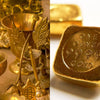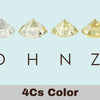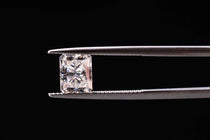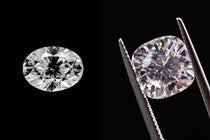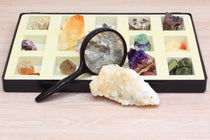In my years of crafting and jewelry design, a lobster clasp has become a familiar tool in my arsenal for creating secure, durable pieces. They're named for their resemblance to the claw of a lobster and are widely used for their ease of use and reliability. A lobster clasp operates with a simple lever mechanism which, when pulled, opens the clasp and allows for the loop of chain or ring from the other end of the jewelry piece to be secured. Releasing the lever then ensures the closure is safely locked.
The versatility of lobster clasps makes them suitable for a range of jewelry styles, from delicate bracelets to heavier necklaces. Since proposing is a significant event that involves a piece of fine jewelry, it is essential that the chosen jewelry contains a reliable fastening like a lobster clasp to ensure that the piece remains securely on your partner's wrist or neck. My experience has taught me that the security of a clasp might seem like a small detail, but it contributes significantly to the overall success and longevity of a piece of jewelry.
Whether I'm creating a simple bracelet or an intricate necklace, I find that choosing the right kind of hardware like a lobster clasp can make all the difference. It must be user-friendly so that the person wearing the jewelry can easily manage it themselves—especially important for pieces like engagement bracelets that may be put on during the emotionally charged moment of a marriage proposal. The choice of a lobster clasp reflects the care and attention to detail that has gone into crafting the piece, ensuring that it not only looks beautiful but functions well for daily wear.
Understanding Lobster Clasps
In the context of jewelry, lobster clasps are a type of fastener commonly used to secure necklaces and bracelets. They are named for their resemblance to the claws of a lobster with their pincer-like design. Lobster clasps are highly popular due to their blend of security and ease of use.
Comprised of a trigger mechanism, they have a small lever, typically made of metal, which, when pressed, opens the clasp. Once released, the clasp closes automatically, ensuring the jewelry remains fastened. The reliability of lobster clasps makes them a preferred choice among various types of jewelry clasps.
- Components of a Lobster Clasp:
- The Body: Usually a tubular or oval shape.
- The Lever: Operated by pressing to open the clasp.
- The Opening: Where the ring or link is placed to secure jewelry.
Lobster clasps come in an array of sizes to accommodate different jewelry weights and styles, from delicate chains to chunky, statement pieces. The metals commonly used in their construction include sterling silver, gold, and stainless steel, offering aesthetic versatility as well as functionality.
Their robust design means they can safely hold pieces adorned with precious stones, like moissanite, without the worry of the jewelry coming undone easily. The use of lobster clasps contributes to the overall durability and longevity of the treasured items in one's jewelry collection.
For jewelers and craft enthusiasts alike, understanding and utilizing the dependable lobster clasp can enhance the quality and wearability of handmade jewelry creations.
Design and Functionality

In my discussion about the lobster clasp, I'll focus on the intricate design and practicality that make it a popular choice for securing jewelry.
Basic Components
The lobster clasp, named for its resemblance to a lobster's claw, is a staple in the jewelry world. Crafted from a sturdy metal, typically sterling silver, gold, or brass, it consists of two main parts: the body and the lever. The body houses a spring mechanism which keeps the clasp closed until pressure is applied to the lever or trigger. When pressed, the claw opens, allowing the opposite end of the chain or necklace to be inserted. Upon releasing the trigger, the spring ensures the clasp snaps back into the closed position, securing the jewelry in place.
Types of Lobster Clasps
Variations in the design of lobster clasps cater to different aesthetics and functionalities. The styles and sizes of these clasps can vary widely, with some intended for delicate pieces of jewelry like a fine chain around the neck, while others are larger and suited for chunkier accessories. Certain lobster clasps feature a more rounded look mimicking the shape of a lobster claw, while others may have a flatter design. The choice of clasp type is influenced by the weight and style of the necklace or chain it is intended to secure, ensuring both safety and coherence in design.
Application in Jewelry

In the realm of jewelry making, the lobster clasp is prized for its security and ease of use. It's a staple fastener in various jewelry designs due to its reliable mechanism.
Common Uses
The lobster clasp is a versatile fastener commonly employed in securing both bracelets and necklaces. Its popularity stems from the clasp's ability to handle different weights and sizes of jewelry, thus offering a dependable closure for a wide range of jewelry designs. It's also a favorite for keychains, where the security of the items attached is paramount.
Selecting the Right Size
When choosing the appropriate size, I consider the weight and size of the piece. For delicate items, a smaller clasp maintains the jewelry's overall daintiness, while heavier pieces require larger clasps for enhanced strength and balance. The selection process is critical; it directly influences the functionality and aesthetics of the finished jewelry.
Attachment Techniques
Proper attachment of a lobster clasp usually involves soldering for a permanent fix or the use of pliers to manipulate jump rings or split rings. As a jeweler, I always make sure that the attachment is secure, and involves a process that does not compromise the integrity of the precious metal or the design. Proper tools like jeweler's pliers are essential in achieving a professional finish that won't give way under the strain of regular use.
Durability and Quality

When assessing the durability and quality of lobster clasps in jewelry, two critical factors stand out: the material choices and the rigor of testing and quality assurance. These aspects determine the clasp's strength and longevity, which are vital for the wearer's satisfaction and safety.
Material Choices
Choosing the right metal for a lobster clasp is paramount. Sterling silver and 14k gold are popular for their balance between purity and strength, offering longevity while also being gentle on the skin. For those looking for a more cost-effective option, steel can be a durable alternative, often enhanced with a protective plating to resist tarnish and wear. Magnetic clasps are an additional feature, appreciated for their ease of use, though not as secure as traditional lobster clasps.
Testing and Quality Assurance
Quality control lab tests are vital for ensuring the clasp's durability. These tests include tension tests to measure strength, and assay examinations to confirm the metal's purity. Superior clasps should pass these rigorous assessments, indicative of their capability to withstand frequent use. While not directly related to lobster clasps, the integrity of gemstone certifications, such as those by GIA, underline the importance of reliable quality assurance in the broader jewelry industry.
Fashion and Style Considerations

In the realm of fashion, lobster clasps serve not only as a practical tool for securing jewelry but also contribute to the overall aesthetic of a piece. As I consider designs, the clasp is not merely functional; it's an integral part of the style statement. Jewelry designers often choose lobster clasps for their timeless appeal and ability to blend seamlessly with a variety of jewelry styles – from classic strands of pearls to more avant-garde geometric pieces.
- Secure: When it comes to fastening bracelets and necklaces, lobster clasps are revered for their security. Their spring-loaded mechanism ensures that the jewelry stays in place.
- Designs: These clasps come in a myriad of designs, ranging from simple and understated to ornate with decorative patterns, catering to diverse fashion senses.
- Styles: They can be discreet to keep the focus on the jewelry or bold to make a statement.
- Magnet: While magnetic clasps are another option for ease of use, they may not offer the same level of security as lobster clasps, especially when paired with heavier, more expensive items.
As I choose my accessories, whether it's to complement a pear-shaped ring or to ensure that my wedding ring is the centerpiece of my ensemble, the clasp is a detail that requires careful consideration. It must not only match the design and style of the piece but also provide a secure hold to ensure peace of mind as I move throughout the day.
While fashion often focuses on the visible elements of jewelry, the functional components, such as clasps, are pivotal in providing both style and security. My selection of a lobster clasp has the potential to subtly enhance the sophistication of my attire, confirming the adage that beauty lies in details.
Usability and Accessibility
When selecting jewelry fasteners, the interplay of usability and accessibility is crucial. A clasp should not only secure the piece but also provide ease of operation, especially for individuals with dexterity issues.
Ease of Use
Lobster clasps are widely acknowledged for their secure locking mechanism. Typically, a simple lever is pressed to open the clasp, allowing the user to attach or detach it with relative ease. However, for those with dexterity issues, the traditional lobster clasp can present a challenge. Modifications like swivel lobster clasps add a rotational feature, reducing the likelihood of the jewelry tangling and making it easier to align and secure without having to manipulate the entire piece of jewelry.
Innovations in Design
Innovations in clasp design aim to enhance usability and accessibility even further. For instance, magnetic clasps employ powerful magnets to securely close jewelry, offering an effortless solution for users who struggle with fine motor skills. The magnet test is a method to ensure that the magnetic force is sufficient to prevent accidental detachment while remaining easy to separate intentionally. Although magnetic clasps can simplify fastening, it's vital to ensure the magnet is strong enough to keep the jewelry secure during use.
Jewelry designers are invested in creating clasps that are not just decorative but also functional, acknowledging that a clasp's usability directly impacts wearability.
Maintenance and Care
| Aspect | Maintenance Tips |
|---|---|
| Regular Cleaning | Wipe the lobster clasp with a soft, damp cloth after each use to remove oils, sweat, and dirt. Avoid using harsh chemicals that may damage the metal. |
| Inspecting for Damage | Regularly check the clasp for signs of wear, such as bent or misaligned components. If any issues are found, consider repairs or replacement. |
| Avoiding Harsh Chemicals | Avoid exposing the lobster clasp to harsh chemicals, including household cleaners and beauty products, as these can tarnish or corrode the metal. |
| Proper Storage | Store jewelry with lobster clasps in a cool, dry place away from direct sunlight. Consider using jewelry pouches or boxes to prevent scratching and tangling. |
| Checking Spring Mechanism | If the clasp has a spring mechanism, periodically check its functionality. Gently press and release to ensure it opens and closes securely. |
| Professional Cleaning | For stubborn dirt or tarnish, consider professional jewelry cleaning services. They can safely clean and polish the lobster clasp without causing damage. |
Caring for your jewelry, particularly pieces with lobster clasps, is crucial for preserving their beauty and functionality. To ensure your clasps operate smoothly and avoid any potential damage, it's important to clean them regularly. When cleaning, I suggest using a gentle, non-abrasive cloth to wipe away any dirt or grime that may have accumulated. It’s also beneficial to occasionally give them a deeper clean. Moisture and liquids can cause tarnishing, so I always make sure my clasps are dry before storing jewelry.
Regarding storage, I keep my jewelry with lobster clasps away from extreme temperatures and environments that could accelerate tarnish. For additional protection against tarnish, I store pieces in a cool, dry place and sometimes use anti-tarnish strips if the climate is particularly humid.
Usage also plays a part in the longevity of your clasps. When I use my jewelry, I ensure to handle the clasps gently to avoid any unnecessary strain that could weaken them over time. It's important to open and close lobster clasps without pulling or twisting them to the side, as maintaining their shape is key for secure fastening.
Lastly, I occasionally inspect my lobster clasps for signs of wear or damage. If I notice any issues, I take my jewelry for professional servicing, as they can provide treatments to restore clasps to their optimal condition. For helpful tips on cleaning jewelry items, you might want to consider visiting how to clean your wedding ring, as the methods can also be applicable to items with lobster clasps.
Troubleshooting Common Issues

When it comes to maintaining lobster clasps, the main issues I tend to encounter include their tendency to become stiff or sticky over time and the occasional need for repair or replacement due to damage such as a dent. Here's how I handle these common challenges.
Repair and Replacement
If my lobster clasp has suffered a dent or is no longer functioning properly, I assess whether it can be repaired. In many cases, I find that using a pair of pliers can help realign any misshapen parts. However, if damage is too extensive, I opt to replace the entire clasp. I ensure that I choose a clasp of the right size and type that matches the original design to maintain the integrity of my jewelry.
- Required Tools for Repair:
- Needle-nose pliers
- Jeweler's pliers
- Steps for Replacement:
- Remove the damaged clasp with pliers.
- Open the jump ring and attach a new clasp.
- Close the jump ring securely to finish.
Handling Sticky or Stiff Clasps
Over time, lobster clasps can become sticky or stiff, which hampers their ease of use. My first step in resolving this issue is to apply proper cleaning techniques. Occasionally, a bit of dirt or buildup is the culprit, and a gentle cleaning solution can resolve the issue. However, if the clasp remains sticky, I carefully apply a tiny amount of lubricant to the trigger mechanism. It's vital to use lubricants sparingly, as too much can attract more dirt.
- Cleaning Steps:
- Soak the clasp in warm soapy water.
- Use a small brush to remove debris.
- Rinse and dry thoroughly before lubricating if necessary.
Creative Uses Beyond Jewelry
Lobster clasps are commonly associated with securing bracelets and necklaces, but their utility extends far beyond traditional jewelry. I find that these versatile components can enhance a variety of fashion accessories and practical items. In the realm of fashion, think of multi-strand clasps adding a functional elegance to handbag closures. They can be effortlessly clicked onto a chain or leather strap, creating a secure yet stylish way to keep your items safe.
Using lobster clasps in crafting can lead to innovative solutions, such as a detachable key ring or as a clasp for a smartphone pouch. These items often require secure but accessible fastening methods, making lobster clasps an ideal choice. In DIY home decor, I've seen them used to attach curtains to rings or to create interchangeable slipcovers for throw pillows, enabling swift style changes.
For those who work with fabric or leather, a lobster clasp can be the anchor for a detachable section of a garment or a cord, enhancing both the functionality and the aesthetic appeal. Be creative and use lobster clasps in your DIY projects like crafting a personal lanyard or securing outdoor equipment, where their robustness and reliability can be incredibly valuable.
Lastly, for artists or those creating handcrafted items, a lobster clasp can contribute to the functionality and resale value of your creations. Incorporate them into your designs with the same confidence that a fine jeweler would, knowing that each clasp adds a touch of class and practicality to your work.
Frequently Asked Questions
In this section, I'll address some common inquiries regarding lobster clasps to give you a better understanding of their mechanism and advantages in jewelry making.
How does a lobster clasp work?
A lobster clasp operates by pushing down on a small lever, which opens the clasp. When released, a spring mechanism closes the clasp around a jump ring or a link in the chain, securing the two ends together.
What are the advantages of using a lobster clasp on jewelry?
Lobster clasps are highly reliable and provide a sturdy closure for jewelry, ensuring that pieces stay secure. They are also quite versatile, suitable for a wide range of jewelry styles and sizes.
How do you attach a lobster clasp to a bracelet?
I attach a lobster clasp to a bracelet by using a jump ring or a split ring. I open the ring, thread it through the hole in the clasp and the loop at the end of the bracelet, and then close the ring to secure the clasp in place.
What is the difference between a lobster clasp and a toggle clasp?
A lobster clasp uses a spring-loaded mechanism for opening and closing, while a toggle clasp consists of a bar that fits through a loop. Toggles can be decorative but are not as secure as lobster clasps.
Can a lobster clasp be used on any type of jewelry?
Yes, a lobster clasp can be used on virtually any type of jewelry, including necklaces, bracelets, and anklets. It's a versatile component that works with different materials and designs.
What should you consider when choosing a clasp for a necklace?
When choosing a clasp for a necklace, I consider the weight and style of the jewelry, the durability of the clasp, and whether the wearer has any dexterity issues that could make using certain types of clasps more challenging.
Checkout some of our top collections:


